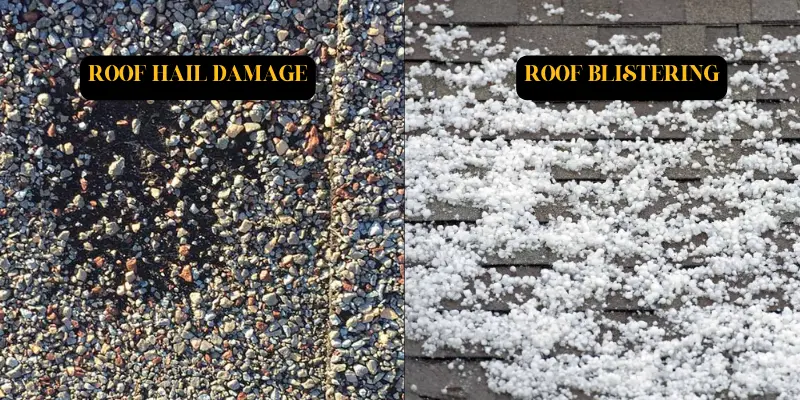When it comes to maintaining the integrity of your roof, understanding the difference between hail damage and blistering is crucial. These two issues can significantly impact your roof’s lifespan, and knowing how to identify and address them can save you time, money, and stress. In this comprehensive guide, we will explore hail damage vs blistering, highlighting their causes, identifying features, and providing solutions to protect your roof.
Hail damage and blistering are common roofing issues that homeowners often encounter. While both can lead to significant problems if left untreated, they have distinct characteristics and require different approaches for repair. In this article, we will delve into the specifics of hail damage vs blistering, offering insights and practical advice to help you maintain a healthy and durable roof.
What is Hail Damage?
Hail damage occurs when hailstones impact the surface of your roof, causing dents, cracks, and even punctures. The severity of hail damage can vary depending on the size and density of the hailstones, as well as the age and condition of your roof.
Causes of Hail Damage
Hail damage is primarily caused by severe weather conditions involving hailstorms. Factors such as wind speed, hailstone size, and the duration of the storm all contribute to the extent of the damage.
Identifying Hail Damage
To identify hail damage, look for the following signs:
- Dents or depressions on shingles
- Cracked or broken shingles
- Exposed or damaged roofing material
- Granule loss on shingles
What is Blistering?
Blistering occurs when small bubbles form on the surface of your roof, usually due to trapped moisture or gas. Over time, these blisters can grow and eventually burst, leading to further damage.
Causes of Blistering
Blistering is often caused by:
- Poor ventilation in the attic
- Excessive heat exposure
- Low-quality roofing materials
- Improper installation techniques
Identifying Blistering
Blistering can be identified by:
- Small, raised bubbles on the shingles
- Clusters of blisters in specific areas
- Blisters that may pop and leave pockmarks
Hail Damage vs Blistering: Key Differences
Understanding the key differences between hail damage and blistering is essential for effective roof maintenance.
Visual Differences
- Hail Damage: Typically appears as dents, cracks, or granule loss.
- Blistering: Manifests as small, raised bubbles on the shingles.
Causes
- Hail Damage: Caused by external factors like hailstorms.
- Blistering: Caused by internal factors such as trapped moisture or heat.
Long-Term Impact
- Hail Damage: Can lead to leaks, structural damage, and reduced roof lifespan.
- Blistering: Can weaken shingles, making them more susceptible to other types of damage.
Solutions for Hail Damage
Addressing hail damage promptly can prevent further deterioration of your roof.
Inspection and Assessment
After a hailstorm, it’s essential to inspect your roof for damage. Consider hiring a professional roofing contractor to conduct a thorough assessment.
Repair and Replacement
Depending on the extent of the damage, repairs may involve:
- Replacing individual shingles
- Patching small cracks or punctures
- Full roof replacement for severe damage
Solutions for Blistering
Properly addressing blistering can extend the life of your roof and improve its performance.
Improve Ventilation
Enhancing attic ventilation can help prevent moisture buildup and reduce blistering.
Use Quality Materials
Investing in high-quality roofing materials can minimize the risk of blistering.
Professional Inspection
Regular professional inspections can identify early signs of blistering and address them before they worsen.
Preventive Measures
Taking preventive measures can help protect your roof from hail damage and blistering.
Regular Maintenance
Regular roof maintenance, including cleaning and inspections, can catch early signs of damage.
Protective Coatings
Applying protective coatings can shield your roof from extreme weather conditions.
Proper Installation
Ensure your roof is installed correctly by hiring experienced professionals.
Table: Comparison of Hail Damage and Blistering
| Feature | Hail Damage | Blistering |
| Visual Appearance | Dents, cracks, granule loss | Small, raised bubbles |
| Primary Causes | Hailstorms, severe weather | Trapped moisture, poor ventilation, heat |
| Long-Term Impact | Leaks, structural damage, reduced roof lifespan | Weakened shingles, increased susceptibility |
| Solutions | Shingle replacement, roof repair | Improve ventilation, use quality materials |
| Preventive Measures | Regular maintenance, protective coatings | Proper installation, regular inspections |
FAQs About Hail Damage vs Blistering
Q1: How can I tell if my roof has hail damage?
A1: Look for dents, cracks, or granule loss on your shingles. If you’re unsure, consider hiring a professional for a thorough inspection.
Q2: Can blistering shingles be repaired?
A2: Yes, blistering shingles can often be repaired by improving attic ventilation and replacing affected shingles with high-quality materials.
Q3: How often should I inspect my roof for damage?
A3: It’s recommended to inspect your roof at least twice a year, in the spring and fall, and after any severe weather events.
Q4: What are the long-term effects of untreated hail damage?
A4: Untreated hail damage can lead to leaks, structural damage, and a reduced lifespan for your roof, potentially resulting in costly repairs.
Q5: Are there specific materials that prevent blistering?
A5: High-quality, properly installed roofing materials with good ventilation can help prevent blistering. Consult with a roofing professional for the best options.
Q6: How does proper installation prevent roof blistering?
A6: Proper installation ensures that shingles are securely placed and ventilation systems are correctly set up, reducing the risk of trapped moisture and heat, which can cause blistering.
Conclusion
Differences between hail damage and blistering is essential for maintaining a healthy roof. By identifying the causes, recognizing the signs, and implementing effective solutions, you can protect your roof from these common issues. For professional roofing services in Miami, FL, contact Hasid On The Roof Florida. Our experienced team is dedicated to providing top-quality roof repair and maintenance to keep your home safe and secure.

